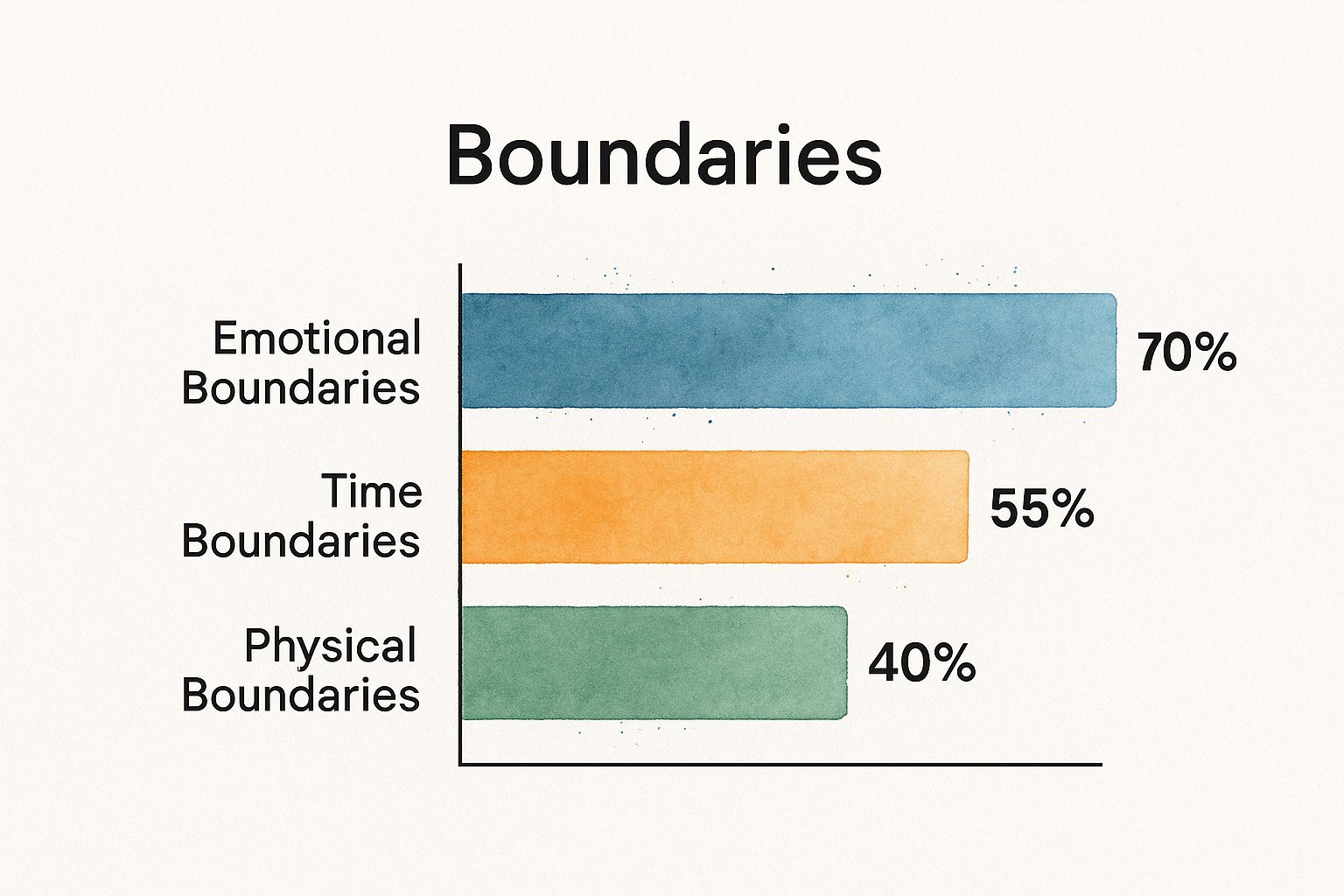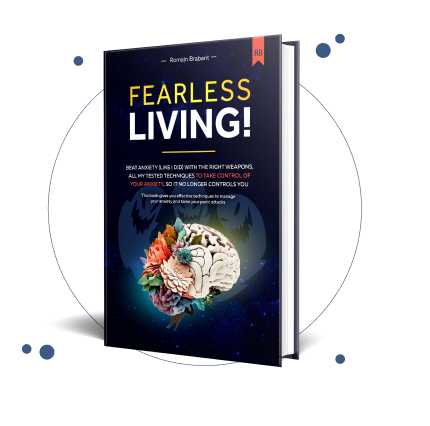
Learning how to set healthy boundaries is so much more than just saying "no." It is a vital and hopeful step on the path to healing from anxiety. It’s a powerful form of self-care, a way of communicating your limits and protecting your most valuable resource: your mental and emotional energy. It's a process—one that involves figuring out what you truly need, clearly communicating those needs, and then consistently holding your ground.
When you master this, stress and anxiety naturally begin to fade, making space for a calmer, more peaceful life. This is not just a coping mechanism; it's a foundational skill for lasting recovery.
Your Hopeful Path From Anxiety to Empowerment
If you're constantly feeling overwhelmed, on edge, or stretched to your absolute limit, a lack of personal boundaries is often the invisible culprit. That nagging feeling that you have to be available to everyone, all the time? It creates a constant state of low-grade stress that quietly fuels your anxiety day in and day out. But there is a way out, and it starts here.

This guide isn't about building walls or becoming confrontational. It's about showing you a clear path to reclaiming your peace. It’s about demonstrating that setting healthy boundaries is a fundamental act of self-respect that can lead you out of the cycle of anxiety and into a calmer, more controlled life. There is real hope for a panic-free future.
Redefining Boundaries as an Act of Self-Care
So many of us are afraid that setting limits will lead to conflict or disappointment. That fear is completely understandable, especially if you’ve spent your life being a people-pleaser. But it's time to reframe that mindset with hope.
Boundaries are not about rejecting other people. They're about honoring your own needs for time, energy, and emotional well-being so you can truly heal.
Think of your personal energy like a bank account. Every time you say "yes" when you really mean "no," you're making a withdrawal. When you constantly overdraw your account, you’re left feeling emotionally bankrupt—a state that leads directly to burnout and anxiety.
A boundary is a form of self-love that tells others what you’re willing to give, where you draw the line, and how much of your energy is available. Setting them is one of the most important ways you can take care of yourself on the journey to recovery.
This journey is about giving you hope. There is a way to heal from anxiety and live a life free from panic, and it starts with understanding that you have every right to protect your peace. Taking small, consistent steps to define and communicate your limits can absolutely transform your mental health.
The Connection Between Boundaries and Anxiety
The link between weak boundaries and anxiety is crystal clear. When your limits are blurry or nonexistent, you might find yourself:
- Feeling Overwhelmed: You take on way too much at work or at home because you just don’t know how to turn down requests.
- Experiencing Resentment: You start to feel unappreciated or taken for granted because your own needs are always on the back burner.
- Struggling with Decisions: You’re constantly paralyzed by worry over how your choices will affect everyone else, which leads to total mental exhaustion.
These patterns lock you into a cycle of stress that can make you feel completely powerless. By learning how to set healthy boundaries, you break that cycle. You start to teach others how to treat you, which builds mutual respect and actually strengthens your relationships, paving the way for a more serene life.
For those looking for structured guidance on this path, exploring a system that offers hope and a clear plan can provide invaluable tools and support. Taking this first step is your hopeful move away from anxiety and toward genuine empowerment and a panic-free life.
Pinpointing Where Your Boundaries Are Failing
Before you can build a stronger defense for your mental well-being, you first need to figure out where the cracks are. Think of it like a diagnostic check-up for your personal energy. Spotting the subtle, everyday signs of poor boundaries is the first hopeful step toward reclaiming your peace from the constant drain of anxiety.
These indicators often hide in plain sight. They show up as feelings of resentment, exhaustion, or being perpetually overwhelmed. It’s that sinking feeling when a particular coworker walks toward your desk, or the immediate tension you feel when a specific family member’s name pops up on your phone.
These are not just random frustrations; they are bright, flashing signals pointing directly to where your boundaries are being crossed. Recognizing them is an empowering act of self-awareness that illuminates the path forward to a calmer life.
Listening to Your Emotional Warning Signs
Your emotions are your most reliable boundary-detection system. Feelings like guilt, resentment, and burnout don’t just appear out of nowhere—they are direct consequences of your limits being consistently ignored, either by others or by yourself.
Do any of these scenarios feel familiar?
- You feel drained after most social interactions. If you leave gatherings feeling depleted rather than energized, it might be a sign you're over-giving your emotional energy without getting enough in return.
- You frequently say "yes" when your mind is screaming "no." This is a classic sign of people-pleasing, often rooted in a fear of disappointing others at the expense of your own needs.
- You feel resentful of people you care about. Resentment is often described as the "boundary" emotion. It’s a clear sign you’re doing more than your share or giving more than feels right to you.
These feelings are your allies. Instead of pushing them away, listen to what they are telling you. They provide crucial data on where you need to learn how to set healthy boundaries to protect your well-being and build a life free from anxiety.
The following infographic illustrates the most common areas where people report struggling with their personal limits.

This data clearly shows that emotional boundaries are the most frequently challenged, highlighting how often our internal peace is compromised by the demands and emotional states of others.
Identifying Common Boundary Breaches in Daily Life
Boundary issues aren't abstract concepts; they happen in concrete, everyday situations. The key is to connect your feelings of anxiety or stress to specific, recurring events. This quick-reference table can help you spot the difference between unhealthy and healthy boundaries in action.
Identifying Boundary Issues in Daily Life
| Life Area | Sign of Unhealthy Boundary | Indicator of a Healthy Boundary |
|---|---|---|
| Work | Regularly staying late to finish a colleague's work, feeling resentful. | Politely declining extra work when your plate is full, protecting your personal time. |
| Family | Feeling obligated to answer intrusive personal questions from relatives. | Stating kindly but firmly, "I'm not comfortable discussing that." |
| Friendships | Acting as a constant emotional dumping ground for a friend who rarely reciprocates. | Expressing that you don't have the emotional capacity for a heavy conversation at that moment. |
| Finances | Loaning money you can't afford to lose out of guilt or pressure. | Saying "no" to financial requests that would put you in a difficult position. |
| Personal Time | Saying "yes" to social plans when you're exhausted and need to recharge. | Prioritizing your need for rest without feeling guilty, even if it disappoints someone. |
Recognizing these patterns in your own life is a major breakthrough. Let’s look at some real-world examples to spark those "aha" moments.
A common one is the workplace time boundary. Your colleague, who is always behind, asks you to stay late again to help them finish a project. You have plans, but the fear of seeming unhelpful makes you agree. You go home late, exhausted and resentful, while they leave on time.
Then there’s the social emotional boundary. A close friend calls you multiple times a week to vent for an hour about their problems, but they rarely ask how you are doing. You end each call feeling emotionally exhausted, as if you've absorbed all their stress.
These repeated interactions create a state of chronic stress. You begin to anticipate the boundary breach, which puts your nervous system on high alert and fuels a constant state of underlying anxiety.
Learning to manage the anxiety that comes with setting a new boundary is crucial for your healing. For those who find this step particularly tough, our guide on using exposure therapy for anxiety can be an incredibly helpful resource. It offers a structured way to face the discomfort that comes with changing old patterns and finding freedom.
Pinpointing these specific moments is your starting point for change. It’s not about blame; it’s about observation. Each time you identify a situation that leaves you feeling drained, you've found an opportunity to set a new, healthy boundary that will ultimately lead you toward a more peaceful, anxiety-free life.
Defining Your Personal Boundaries for a Calmer Life
You’ve pinpointed the moments your boundaries get pushed. That’s a huge first step toward healing. Now, we get to the empowering work—the part where you move from seeing the problem to actively deciding what you need to feel safe, respected, and in control.
This is a deeply personal process. It isn't about building walls or punishing people. It's about finally honoring yourself and creating the conditions for a panic-free life.

A lot of people think boundaries are these rigid, unchanging rules, but that's not really how they work. Think of them more as an ongoing conversation you have with yourself and the world—something you adjust over time. Research on work-life boundaries shows just how different we all are; some people need a hard stop between their job and their personal life, while others are fine with a little overlap.
The takeaway here is that learning how to set healthy boundaries is about finding a system that works for you. It needs to be stable enough to protect you but flexible enough to adapt as you heal and grow.
This section is all about helping you sketch out your own "boundary map." It's a personal guide that will feel authentic, empowering you to protect your well-being from the constant pressures that feed anxiety.
Mapping Your Core Needs Through Self-Reflection
To define your limits, you have to get clear on your needs first. And one of the most powerful ways to do that? Journaling. It’s a private space to explore your feelings without any judgment and start spotting patterns you might miss in the rush of daily life.
So, grab a notebook, find a quiet moment, and just let your thoughts flow with these prompts. Don't edit or censor yourself. Just write.
-
When do I feel most resentful? Think about the specific requests or interactions that leave a sour taste. Is it when a friend always cancels last minute? Or when your boss sends "just one more thing" after 6 PM? Resentment is a flashing red light that a boundary has been crossed.
-
What requests always make me anxious? Pinpoint the triggers that send your stomach into knots. Maybe it’s a family member asking to borrow money, an invitation to a huge party, or being asked to take on one more task when your plate is already overflowing.
-
What conversations leave me feeling totally drained? Some topics or people just suck the life out of you. Naming them helps you figure out where you need to draw crucial emotional and conversational lines.
-
What do I need more of in my day to feel calm and safe? Is it quiet? Creative space? Unstructured time with your kids? Or just ten minutes to drink your coffee in peace before the day starts? Your needs point directly to the boundaries you must create to protect them.
Answering these questions honestly will start to reveal where you need stronger fences—whether it's with your time, your energy, your emotions, or your need for basic respect. This isn’t about creating a rigid rulebook; it's about identifying your non-negotiables for a sane, peaceful life.
Your personal limits aren't selfish demands. They are the essential requirements for your mental and emotional survival. Defining them is the first step toward teaching others how to treat you with the respect you deserve, and a hopeful step toward healing.
Moving Past the Guilt of Putting Yourself First
Once you start getting clear on your limits, a new, very familiar obstacle often pops up: guilt.
If you're used to being the "helper," the "peacemaker," or the one who always says yes, the simple act of prioritizing your own needs can feel incredibly selfish. That feeling is completely normal, but you can overcome it. This is a critical part of your recovery.
Think of it this way: a car can't run on an empty tank. You can't give your best to anyone or anything when you're running on fumes. Setting boundaries is how you refuel. It’s what ensures you have the energy, patience, and clarity to show up as the best version of yourself and continue your healing journey.
Here are a few powerful ways to reframe that guilt when it creeps in:
- Instead of "I'm being selfish," try "I'm practicing self-preservation to heal." Protecting your energy isn't an indulgence; it's a basic need, just like eating or sleeping.
- Instead of "I'm letting them down," try "I'm modeling healthy behavior." When you respect your own limits, you give others permission to do the same. You're showing them that it's okay for everyone to have needs.
- Instead of "They will be angry," try "Their reaction is their responsibility." You can only control your own actions and intentions. If someone reacts poorly to a reasonable boundary, it usually just confirms why that boundary was so necessary in the first place.
By working through this, you'll have a foundational boundary map. It's not set in stone; it's a living document that will grow and change with you. But it gives you the clarity and confidence you need for the next crucial step: communicating these limits with kindness and conviction.
Communicating Boundaries with Clarity and Kindness
Alright, you've done the hard work of figuring out what your limits are. Now comes the part that often makes our palms sweat: telling other people about them.
This is where the anxiety usually kicks in. We get flooded with worries about sounding selfish, rude, or confrontational. But let's reframe this with hope. Communicating a boundary isn't about building a wall; it's about building a healthier, more respectful relationship where you can feel safe and at peace.
The goal here is to be clear, calm, and kind. You're not starting a fight. You're simply stating what you need to take care of yourself. That shift in perspective is everything—it's how you move from feeling anxious to feeling empowered and hopeful about your future.
The Power of "I" Statements
If there's one tool you need in your communication toolkit, it's the "I" statement. This simple technique is a game-changer because it lets you express your feelings without blaming or accusing the other person, which almost always makes them defensive. It turns a potential confrontation into a conversation about healing.
An "I" statement keeps the focus on your experience. It has a basic structure: "I feel [your emotion] when [the specific behavior happens], and I need [what you need to change]."
- Instead of: "You always interrupt me, and it's so rude."
- Try: "I feel unheard when I get interrupted, and I need to be able to finish my thought."
See the difference? The second one invites collaboration instead of conflict. It makes it clear that your boundary is about your needs, not their flaws, which makes it so much easier for them to hear you out.
Practical Scripts for Real-Life Scenarios
Knowing the formula is one thing, but having the right words ready in the heat of the moment is another. Here are a few scripts you can tweak for those common, tricky situations. Remember, each one is a step toward a panic-free life.
Professional Scenarios
Setting boundaries at work is non-negotiable if you want to avoid burnout. A 2023 study from LendingTree found that 57% of employees who set work boundaries reported a better work-life balance. However, the study also noted that pushback is common, which just highlights why clear communication is so important. You can find out more about how boundaries impact work-life dynamics.
Here's how to handle a classic workplace dilemma:
The Situation: It's 4:45 PM on a Friday, and your boss drops another "urgent" project on your desk.
- What you might feel: Anxious, resentful, and cornered into saying yes.
- What you can say: "I understand this is a priority, and I want to give it my full attention. I'm just wrapping up for the day, but I can make it the very first thing I tackle on Monday morning."
- Why it works: You sound like a team player while firmly protecting your own time.
Social Scenarios
Friendships are supposed to be a source of support, not stress. Sometimes, you have to set a limit to keep a relationship from becoming draining so you can protect your healing energy.
The Situation: A friend constantly vents about their problems but never once asks how you're doing.
- What you might feel: Drained, used, and invisible.
- What you can say: "I really care about you and I'm here for you, but I’ve noticed our chats have felt a little one-sided lately. I’m going through some things too, and I really need our friendship to feel like a two-way street."
- Why it works: It’s honest and direct about your need for mutual support without invalidating their feelings.
Family Scenarios
Let's be honest, family dynamics can be the toughest to change. But setting boundaries here can also be the most rewarding for your long-term peace.
The Situation: A family member expects you to drop everything for a non-urgent request.
- What you might feel: Guilty, obligated, and seriously frustrated.
- What you can say: "I love you and I want to help, but I just can't do that right now. I'm free on Saturday morning if that would work for you."
- Why it works: You give a clear "no" to the immediate demand but offer a reasonable alternative, showing you still care.
Handling Pushback with Grace
Not everyone is going to throw a party when you introduce your new boundaries, especially if they’ve benefited from you not having any. Expect some pushback. It’s a normal part of the process. The trick is to stay calm and refuse to be pulled into an argument.
When someone resists, remember that their reaction is about their feelings, not your worth. You do not need to over-explain, justify, or defend your boundary.
Your boundary is valid simply because you need it. You don’t owe anyone a dissertation on why you need to protect your energy. A simple, "I understand this is new, but this is what I need to do for myself," is more than enough.
If you feel your anxiety spiking in these moments, it helps to have a few tools at the ready. Our guide on grounding techniques for anxiety has some fantastic, practical methods to help you stay centered when you feel your composure slipping.
Remember, every single time you communicate a boundary, you're reinforcing your own self-worth. You're taking a concrete step toward a life with less anxiety and more peace. It gets easier with practice, I promise. There is hope.
How to Maintain Boundaries for Lasting Freedom from Anxiety
Setting a boundary for the first time is a massive step. It's you reclaiming your peace of mind. But the real work—the kind that creates lasting change and dials down the panic—is in holding those boundaries day after day. This is how you build a new, panic-free life.
It’s not a one-and-done fix. It's a continuous practice of self-love and commitment to your healing.

Life doesn’t stand still. A new job, a growing family, or even a global shift in how we work can suddenly put immense pressure on the very limits you’ve fought so hard to create. The goal isn't to build rigid, unbreakable walls. It’s to develop a flexible, resilient approach that honors your needs through every season of life.
Navigating Modern Boundary Challenges
Let's be honest: the lines between our personal and professional lives have never been more blurred. With remote work and our phones always in hand, we're facing new, complex challenges for anyone learning how to set healthy boundaries.
Research on post-pandemic work life has even given this a name: "boundary collapse." It's that feeling where the separation between your work and home life just dissolves. This can absolutely spike your stress levels, but the study also found that people who actively manage it can thrive. They pointed to strategies like creating clear separations to protect personal time. You can read more about these findings on work-life integration here.
Here are a couple of modern scenarios you might recognize:
- The "Always-On" Work Culture: Your boss pings you with emails at 10 PM. Your team's group chat is buzzing on a Sunday. There's this unspoken expectation that you should always be available.
- The Digital Social Drain: Social media can feel like a relentless demand for your attention and emotional energy. It blurs the lines between genuine connection and a feeling of obligation.
These pressures require modern boundaries. Maybe that looks like setting a firm rule: "I don't check work emails after 6 PM." Or maybe it's scheduling specific "digital detox" periods where notifications are off, giving you a chance to reclaim your mental space.
Your peace isn't a luxury; it's a necessity. Maintaining your boundaries in the face of these modern pressures is a radical act of self-preservation that directly fights back against anxiety and helps you heal.
The Art of Flexibility and Reassessment
A healthy boundary isn't a rigid cage. Sometimes, a situation calls for a little flexibility. The real art is knowing when a boundary can bend without breaking your spirit.
For example, you might have a strict "no work on weekends" rule. But if a truly critical, one-off project needs a few hours on a Saturday, you might choose to be flexible. The key is making it a conscious choice, not a reluctant obligation. You also need to make sure you reclaim that time for yourself later.
This is where checking in with yourself regularly becomes so important. Life evolves, and your boundaries should, too.
Ask yourself these questions every so often:
- Is this boundary still serving my healing? A limit that was absolutely essential last year might feel too restrictive now, or maybe not restrictive enough.
- Where am I feeling resentment again? Resentment is your internal alarm system. It’s a bright, flashing sign that a boundary needs to be reinforced or adjusted.
- Have my priorities shifted? What mattered most five years ago might be different today. Your boundaries need to reflect your current values and needs for a peaceful life.
This process of reassessment turns boundary setting from a defensive reaction into a proactive habit of self-care. It’s about consciously designing a life that supports your well-being, not just constantly fighting to protect it.
Building Resilience for the Long Haul
Maintaining boundaries is a skill that gets stronger with practice. Every time you hold firm, you build more resilience and reinforce your own self-worth. You are teaching yourself—and the world around you—that your needs are valid and that you are capable of healing.
This whole journey is about proving to yourself that there is hope. There is a clear path to healing from anxiety and living a life that feels calm and controlled. Each boundary you maintain is another step forward. This consistent effort is one of the most vital anxiety recovery steps you can take.
Think of it like tending a garden. You can't just plant the seeds and walk away. You have to water them, pull the weeds, and adjust for the seasons. Maintaining your boundaries is the ongoing care that allows your inner peace to grow and flourish, securing the lasting, panic-free calm you've worked so hard to achieve.
Got Questions About Setting Boundaries? Let's Talk.
Putting boundaries into practice for the first time often kicks up a storm of "what ifs." This is where the rubber meets the road—and where old anxieties love to make a comeback. Don't worry, that's completely normal and part of the healing process.
Let's walk through some of the most common fears together. The goal here isn't just to give you answers, but to arm you with confidence and remind you that every single boundary is a step toward a calmer, more authentic, panic-free life. This is where you turn knowledge into real-world peace of mind.
What If Someone Gets Angry When I Set a Boundary?
This is the big one, isn't it? The fear that someone will blow up. But I want you to try reframing this. An angry reaction isn't a sign you did something wrong. It's often confirmation that the boundary was desperately needed.
Their reaction is about them, not you. It's their stuff, their expectations, their discomfort. Your only job is to stay grounded in your decision to heal. You don't have to defend it, justify it, or get dragged into a debate.
Just calmly repeat your limit. A simple, "I understand this is new, but this is what I need," is powerful.
Remember, the people who truly respect you might be surprised at first, but they will eventually adapt. Those who consistently push back? They're showing you exactly where stronger boundaries are required for your well-being.
How Can I Set Boundaries with My Family Without Starting a War?
Family dynamics are tricky, tangled up in years of history and unspoken rules. The secret is to start small and be incredibly consistent. Trying to overhaul everything at once is a surefire way to get overwhelmed and give up.
Pick one low-stakes issue to start with. Maybe it's about not answering calls after a certain hour or limiting unsolicited advice on a specific topic.
When you communicate, use "I" statements. They feel less like an accusation and more like a personal need on your healing journey. For instance:
- Instead of: "You always call me at the worst times and stress me out!"
- Try: "I really love our chats, but I need to start winding down after 9 PM to protect my peace. Would it work to talk a little earlier in the evening?"
This shifts the focus to a solution. Your family might test the new boundary—that’s human nature. Your calm consistency is what will gently retrain the dynamic and guide the relationship toward a healthier, more respectful place for everyone.
I Feel So Guilty and Selfish. How Do I Stop?
Ah, guilt. It's the number one roadblock, especially if you're a natural-born caretaker or people-pleaser. The most effective way to dismantle that guilt is to challenge it with a new truth: Setting a boundary isn't selfish; it's an act of self-preservation essential for your recovery.
Think about it. You don't feel selfish for putting on a coat when it's cold or eating when you're hungry. Protecting your mental and emotional energy is just as fundamental to your well-being. If you run yourself into the ground with no limits, you'll end up burned out, resentful, and with nothing left to give anyone—including yourself.
Start with tiny boundaries. Each time you protect your time or energy and see the positive result—less stress, more patience, a feeling of calm—that guilt will get a little quieter. You're proving to yourself, one small action at a time, that this is an act of deep responsibility.
Is It Too Late to Set Boundaries in a Long-Term Relationship?
It is never too late to start advocating for yourself. Ever. While changing patterns that have been in place for years is definitely a challenge, it’s also one of the most powerful things you can do to revitalize a long-term relationship and bring more peace into your life.
The key is to approach it as a team. This isn't about drawing a line in the sand; it's about inviting your partner to help build a healthier dynamic with you.
Start with an open conversation, framing it as a way to strengthen your bond. You could say something like, "Our relationship means everything to me, and I want to make sure I'm showing up as my best self for us. To do that, I'm realizing I need to get better at communicating my limits around [a specific issue]."
This will take patience from both of you. But the payoff is huge: a relationship built on deeper mutual respect and a more authentic connection. It's not about creating distance; it's about creating a healthier space for you both to thrive.
At The Anxiety Checklist, we believe that everyone deserves to live a life free from the grip of panic and anxiety. There is a way to heal. Our Fearless Living system is designed to give you practical, actionable tools to reclaim your peace, one healthy boundary at a time. If you’re ready to take the next step on your hopeful journey to live panic-free, we’re here to guide you. Learn more and get started today at https://anxietychecklist.com.

